Experience Linux in Your Browser: 15 Free Open-source Tools You Should Know About
Table of Content
Let me share something amazing that completely changed how I learned Linux! As someone who was once terrified of breaking their computer while learning Linux commands (yes, I've had my fair share of "oops" moments 😅), discovering browser-based Linux was like finding a secret cheat code!
You know that feeling when you want to try something new but worry about messing things up? That was totally me before I stumbled upon these awesome browser-based Linux tools.
It was like getting a playground where I could experiment without fear – imagine having an "undo" button for everything!
I remember my first time using one of these tools – I was sitting in my favorite coffee shop, sipping my latte, and casually learning Linux commands without having to dual-boot or set up a virtual machine. How cool is that? 🚀
The best part? There are 15 fantastic, completely free, open-source options out there! I've spent countless hours playing around with them, and let me tell you, it's like having a Linux sandbox right in your browser tab. Want to try that slightly scary command you read about? Go for it! Want to test drive Ubuntu before committing?
You can do that too!
These tools have been absolute lifesavers for me when:
- Learning new commands (without the fear of breaking anything!)
- Testing out different Linux distributions (distro-hopping from my browser? Yes please!)
- Working on different machines (my Linux playground follows me everywhere!)
- Teaching others about Linux (showing is better than telling, right?)
The freedom to experiment without consequences has made learning so much more fun and less stressful.
It's like having training wheels while learning to ride a bike – you get all the experience with none of the scrapes!
I'm super excited to share these tools with you because they've made such a difference in my Linux journey. Whether you're just starting out or you're a seasoned dev looking to safely test some scripts, these browser-based options are absolutely brilliant!
Want to know which ones I've found most helpful? Or curious about specific features that made my learning journey easier? Let's chat about it!
What aspect of Linux are you most excited to explore in a risk-free environment? 😊
1- DistroSea
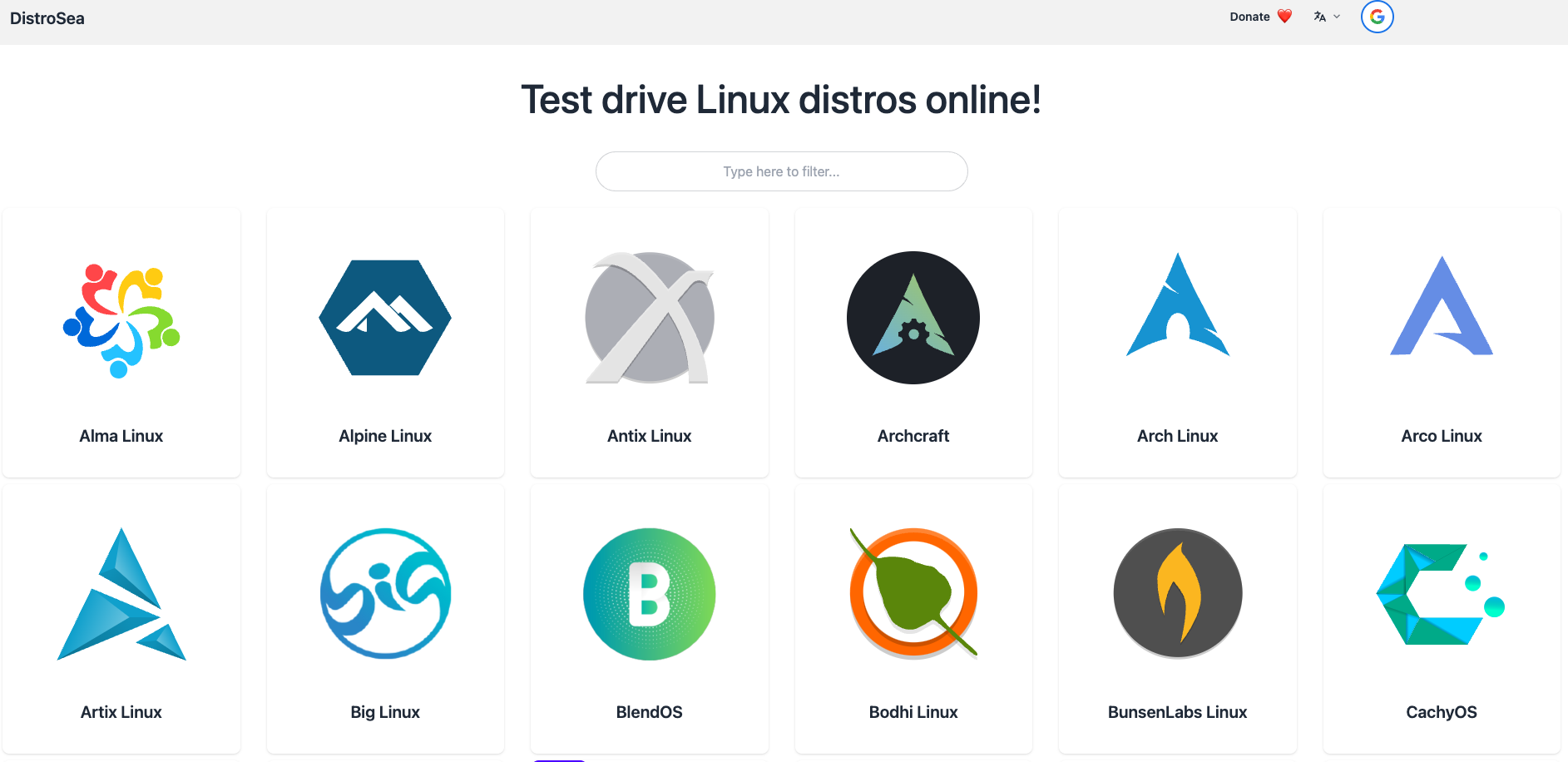
DistroSea is an online platform that lets users test various Linux distributions directly from their browser, without any installation required. It provides a quick and easy way to try out different operating systems, such as Ubuntu, Fedora, and Manjaro, before deciding to install them.
Ideal for both beginners and advanced users, DistroSea helps you explore and evaluate Linux distros effortlessly in a virtual environment.
DistroSea enable you to run and test 50+ operating systems with 500+ different versions.

2- Copy.sh
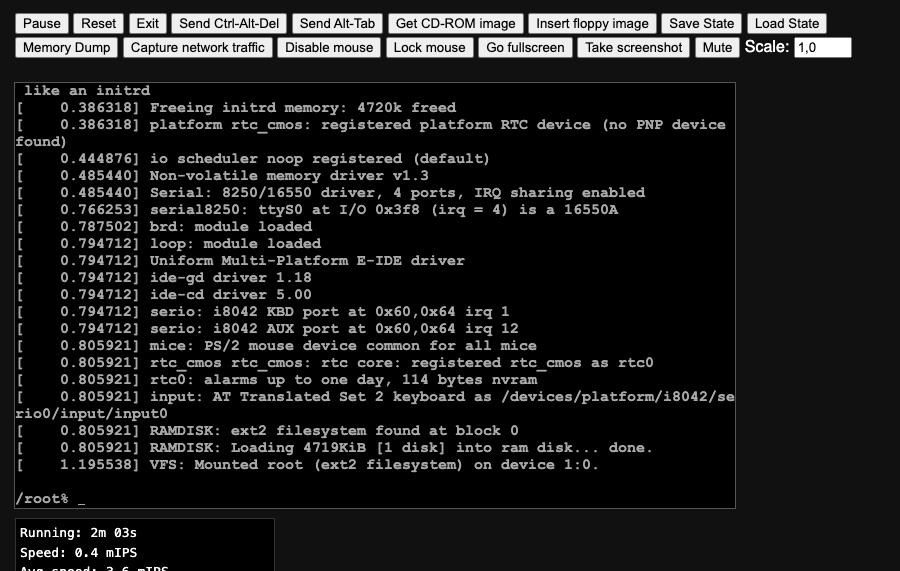
Copy.sh allows you to run Linux and Linux terminal directly online. It supports Arch Linux, FreeDOS, OpenBSD, Solar OS, KolibriOS, and even Windows 98.
It is fast, and user-friendly, and can offer a high educational values in classroom to introduce Linux and similar old systems.
3- Web Terminal
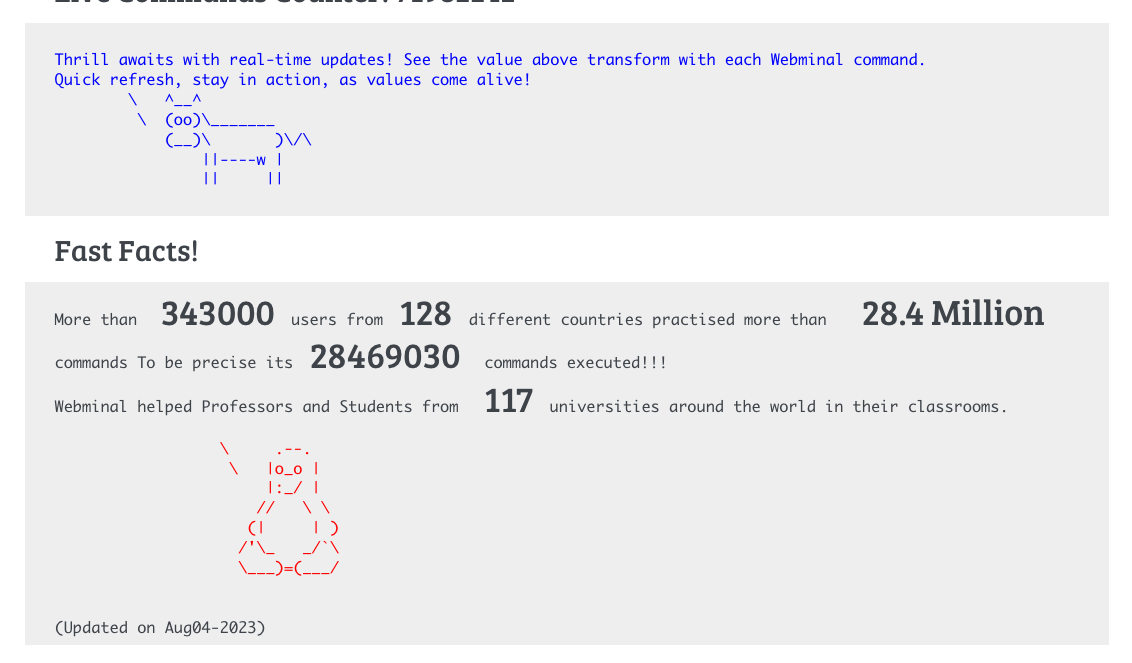
Webminal is an online platform that provides a virtual terminal for practicing Linux commands and programming in various languages directly from your browser. It’s a great tool for beginners and those looking to hone their skills in a hands-on, interactive environment.
I've used Webminal on several occasions to practice Linux and improve my command-line skills in a convenient and accessible way.
The app offers a great tool for learning and practicing Linux and MySQL in a safe, controlled environment!
Features
- Online Linux Terminal: No installation required.
- Practice Linux Skills: Work on file system navigation, file management, scripting in Bash/awk/sed, and MySQL.
- Storage: 100MB of personal storage.
- File Limit: Create up to 1000 files, max size 1MB.
- Share Files: Collaborate by sharing files with community members for debugging or verification.
- Process Limits: Run up to 10 processes simultaneously, max 15 open files per process.
- Group Sharing: Create groups to share files with other members.
- MySQL Features:
- 4 tables max, 200KB database size.
- 200 queries per hour, 100 updates per hour.
- Single MySQL connection.
- No snooping on other users’ databases.
4- JSLinux
JSLinux enables you to run Linux directly from your browser. It current supports Alpine Linux Console, X Window, Graphical, and Fedora. You can also run Windows 2000, and FreeDOS.
5- linuxWeb
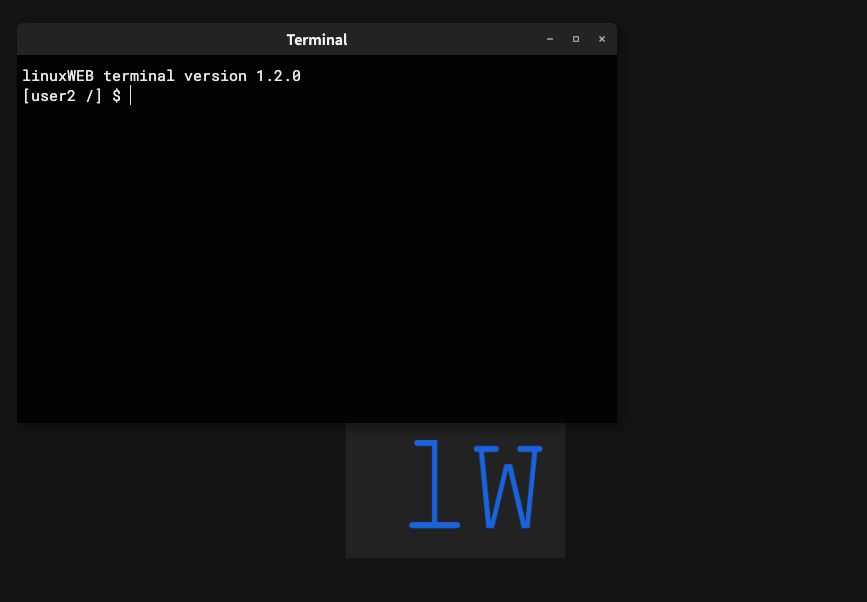
linuxWeb provide a simulated Linux that you can run from your browser. It is an educational web app, that can provide a good intro for Linux users. You can check the Demo here.
6- WebVM
WebVM is a server-less virtual environment running fully client-side in HTML5/WebAssembly. It's designed to be Linux ABI-compatible. It runs an unmodified Debian distribution including many native development toolchains.
WebVM is powered by the CheerpX virtualization engine, and enables safe, sandboxed client-side execution of x86 binaries on any browser. CheerpX includes an x86-to-WebAssembly JIT compiler, a virtual block-based file system, and a Linux syscall emulator.
The post introduces Mini.WebVM, a simplified version of WebVM, which allows users to deploy a fully functional Linux-like environment in their browser. Based on CheerpX, this virtual machine runs entirely client-side using WebAssembly.
The project now allows anyone to easily fork and customize their own WebVM using GitHub Pages and a Dockerfile, streamlining the process.
It also includes improvements like the ability to handle disk images more efficiently and adds networking support. The tool is aimed at developers looking to experiment with Linux in the browser.
7- Browser Shell
Browser Shell is a web-based tool that allows users to run a terminal-like interface directly in the browser. It provides an environment for practicing Linux commands and scripting without needing any setup or installations.
This can be especially useful for developers, learners, or anyone looking to familiarize themselves with command-line operations in a secure and accessible way.
8- Linux on the Web (LOTW)
This GitHub project offers a collection of Linux-related resources and tutorials for users who want to explore Linux from a browser-based interface.
It provides easy access to Linux commands, tools, and guides, helping beginners and enthusiasts practice and improve their skills. This resource can be especially useful for learning Linux without needing to install anything locally.
9- Browser Shell
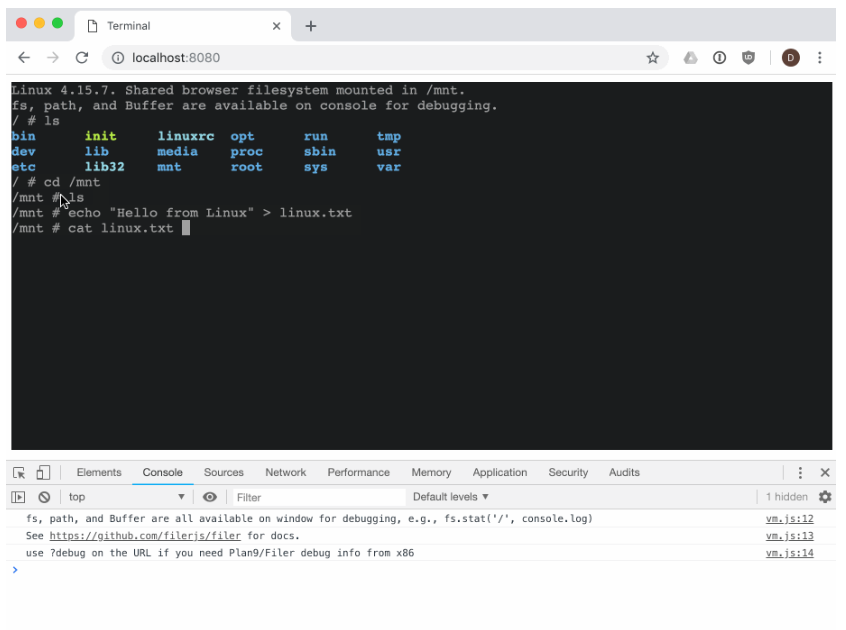
A Linux shell in the browser via forked v86, with bi-directional POSIX filesystem (via Filer) shared over Plan 9 resource sharing.
The Filer filesystem in the browser is mounted in the Linux VM at /mnt.
10- lkl.js
LKL.js is Linux Kernel Library ported to JavaScript using Emscripten. Unlike JSLinux, LKL.js includes a Linux kernel fully written in JavaScript and runs without emulators. For more details, read my blog post
LKL.js just boots Linux kernel and still completely useless. It shows how Emscripten is powerful and how Linux kernel is flexible.
LKL.js requires SharedArrayBuffer for pthread support. SharedArrayBuffer is disabled by default due to Spectre mitigation in Mozilla Firefox. Please enable it. (javascript.options.shared_memory in Mozilla Firefox) The link below is boot.js demo site.
11- Browser linux
Browser Linux is yet another JavaScript based project that enables you to run Linux and Linux commands in browser.
It uses several libraries as v86, localforge, and xtermjs.
However, unlike similar projects, it is a bit slow, and does not include command documentation files, or any package manager of sorts.
12- WebVM.io
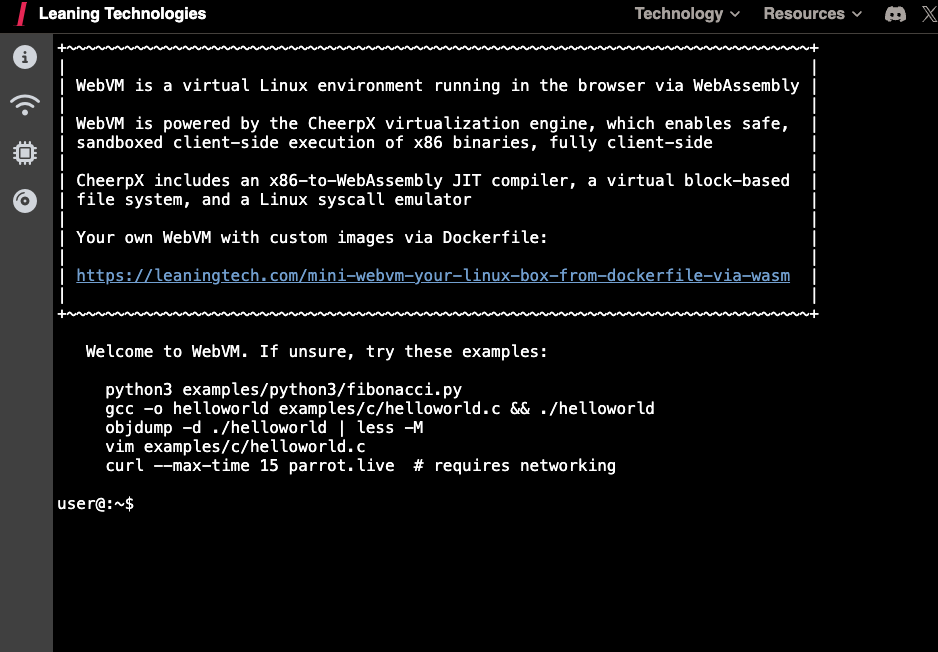
WebVM is a platform that enables users to run a Linux virtual machine (VM) directly in a web browser, powered by WebAssembly.
This tool allows anyone to experience and interact with a full Linux environment without needing any installation, making it ideal for learning, testing, or experimenting with Linux commands and applications.
It's a great resource for developers, students, or anyone interested in exploring Linux on the web.
13- JS/UIX - Terminal
JS/UIX is a UNIX-like operating system written in JavaScript, designed to run directly in web browsers without requiring plugins. It features a virtual machine, shell, file system, and process management, offering a terminal interface with keyboard and screen mapping.
While compatible with modern browsers, it's not free software. For free alternatives, you can explore other terminal interfaces like mass's termlib.js.
14- Linuxzoo
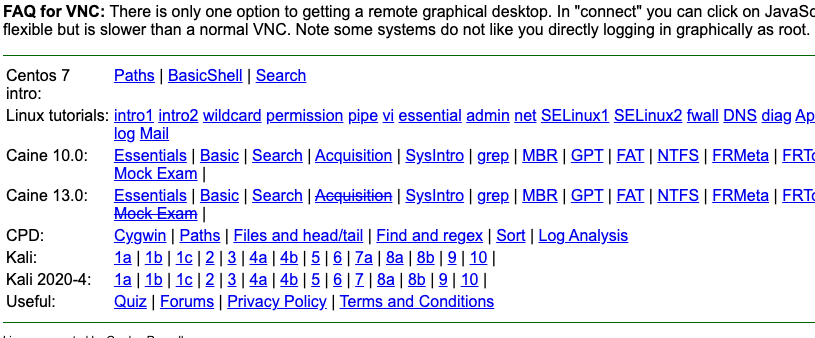
LinuxZoo is a platform that allows users to remotely access private Linux machines with root privileges. It provides an environment for learning Linux, system administration, and forensics using virtual machines running CentOS, Kali, and Caine Forensics distributions. The site supports both command-line and graphical interfaces, offering tools like telnet and VNC for connectivity.
It's designed for learners to practice Linux commands, scripting, and security analysis without the need for local setup. You can register, join queues for available machines, and access various tutorials for hands-on learning.
15- Shells.com
Shells offers cloud-powered virtual desktops, allowing users to turn any device into a fully functional computer. You can access your workspace from any device, whether it's a tablet, old laptop, or TV.
Shells supports various operating systems, including Linux and Windows, and provides a secure, backup-enabled environment. With flexible pricing, users can upgrade their performance easily. It's a great solution for students, coders, and businesses, enabling seamless work and collaboration from anywhere.









